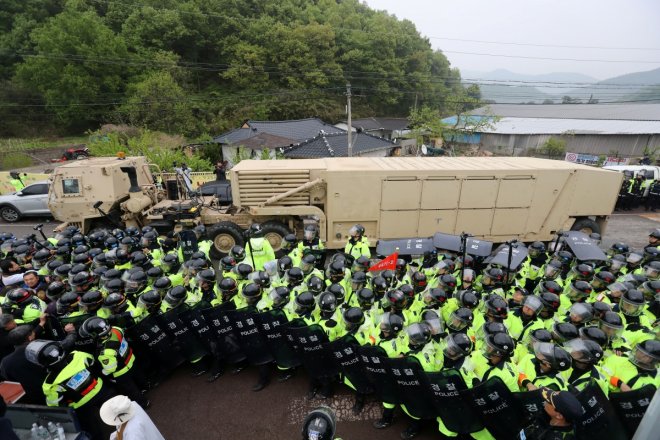
The U.S. military started moving parts of its controversial THAAD anti-missile defense system to a deployment site in South Korea on Wednesday amid high tensions over North Korea's missile and nuclear programs.
Yonhap news agency reported that the arrival of six trailers at the golf course location sparked clashes between locals and police. The earlier-than-expected move was protested by hundreds of local residents. The frontrunner in South Korea's presidential election, Moon Jae-in, also denounced the step.
A spokesman for Moon Jae-in said the decision "ignored public opinion and due process". They demanded the deployment to be suspended until the next administration was in place and had made its policy decision.
Last year, the United States and South Korea had agreed to deploy the Terminal High Altitude Area Defense (THAAD) system in order to counter the threat of missile launches by North Korea. However the move has angered China, which says the advanced system will do little to deter the North and destabilize the regional security balance.
South Korea's defense ministry said some elements of THAAD were moved to the site on what had been a golf course in the south of the country.
"South Korea and the United States have been working to secure an early operational capability of the THAAD system in response to North Korea's advancing nuclear and missile threat," the ministry said in a statement. The battery is expected to be operational by the end of the year, the statement added.

The THAAD system is meant to intercept and destroy short and medium-range ballistic missiles during their final phase of flight. Recently, North Korea has been pushing ahead with its ballistic missile programme despite multiple sets of UN sanctions. Hence, Washington and Seoul are deploying THAAD battery to counter the threat.
Both, the United States and South Korea decided to the early deployment of the missile defence system after talks between the South's acting president and visiting US Vice President Mike Pence, earlier this month.
In recent months, tensions on the Korean peninsula have soared as North Korea's missile tests have brought ever-more bellicose warnings from US President Donald Trump's administration. Pyongyang is believed to be preparing for a sixth nuclear weapons test.
The United States deployed an aircraft carrier strike group led by the USS Carl Vinson to the western Pacific in response to rising tension over the North's nuclear and missile tests. US President Donald Trump indicated that he is willing to ramp up US military pressure on North Korea. However, simultaneously the US will also encourage China to use its influence on its ally, and reject bilateral diplomacy with Pyongyang.
The US has long pushed for China to make more efforts to curb Pyongyang's behaviour. But, Beijing has always resisted to make new efforts. According to analysts, China is concerned that a regime collapse could trigger a flood of refugees across the border and leave the US military on its doorstep.
However, with the experts warning of the possibility of a sixth nuclear test by the North, China has become increasingly concerned. On Monday, Chinese President Xi Jinping called for "restraint" regarding North Korea in a telephone conversation with Trump.
US defence leaders and other top officials are to give a classified briefing on North Korea to all senators in an unusual meeting at the White House later on Wednesday.








